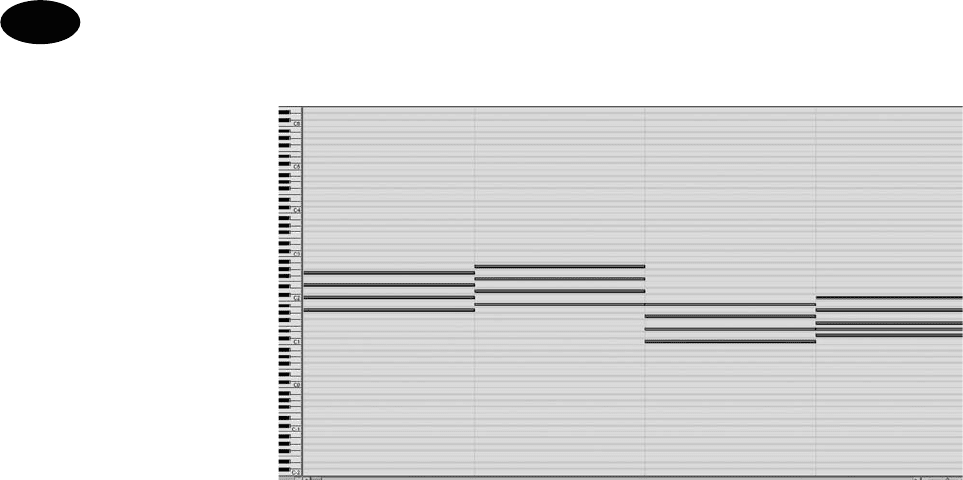Snoman R. Dance Music Manual: Tools, Toys, and Techniques
Подождите немного. Документ загружается.


PART 2
Dance Genres
354
it’s played. Alternatively, you can use an LFO set to a sine wave with a slow rate
and set it to start at the beginning of every note.
Experimentation is the key, changing the attack, decay and release of the amp
or/and fi lter EG from linear to convex or concave will also create new varia-
tions. For example, the decay to a convex slope setting will produce a more
rounded bass timbre. Similarly, small amounts of controlled distortion or very
light fl anging can also add movement.
Alongside the synthetic basses, many drum ‘n’ bass tracks will employ a real
bass. More often than not these are sampled from other records – commonly
dancehall or raga, but they are also occasionally taken from sample CDs rather
than programmed in MIDI. Provided that you have (a) plenty of patience, (b)
a willingness to learn MIDI programming and (c) a good tone or bass module
(such as Spectrasonics Trilogy, EW QL Collosus or any professional MIDI tone
module), it is possible to programme a realistic bass that could fool most lis-
teners. This not only prevents any problems with clearing copyright but it also
allows you to model the bass to your needs.
Programming a realistic bass has already been covered in detail within the
chapter on house, but if you’ve jumped directly to this chapter what follows is
a rundown on how to programme a realistic sounding bass instrument.
The key to programming any real instrument is to take note of how they’re
played and then emulate this action with MIDI and a series of CC com-
mands. In this case, most bass guitars use the fi rst four strings of a normal
guitar E –A–D–G, which are tuned an octave lower, resulting in the E being
close to three octaves below middle C. Also they are monophonic, not poly-
phonic, so the only time notes will actually overlap is when the resonance of
the previous string is still dying away as the next note is plucked. This effect
can be emulated by leaving the preceding note playing for a few ticks while
the next note in the sequence has started. The strings can either be plucked
or struck and the two techniques produce different results. If the string is
plucked, the sound is much brighter and has a longer resonance than if it
were simply struck. To copy this, the velocity will need to be mapped to the
fi lter cut-off of the bass module so that higher values open the fi lter more.
Not all notes will be struck at the same velocity, though. If the bassist is play-
ing a fast rhythm the consecutive notes will commonly have less velocity
since he has to move his hand and pluck the next string quickly. Naturally,
this is only a guideline and you should edit each velocity value until it pro-
duces a realistic feel.
Depending on the ‘bassist’, they may also use a technique known as ‘hammer
on’ whereby they play a string and then hit a different pitch on the fret. This
results in the pitch changing without actually being accompanied with another
pluck of the string. To emulate this, you’ll need to make use of pitch bend.
First set the pitch bend to a maximum limit of 2 semitones, since guitars don’t

Drum ‘n’ Bass
CHAPTER 18
355
‘bend’ any further than this. Begin by programming 2 notes, for instance an
E0 followed by an A0 and leave the E0 playing underneath the successive A0
for around a hundred ticks. At the very beginning of the bass track, drop in
a pitch bend message to ensure that it’s set midway (i.e. no pitch bend) and
just before where the second note occurs, drop in another pitch bend mes-
sage to bend the tone up to A0. If this is programmed correctly, on play back
you’ll notice that as the E0 ends the pitch will bend upwards to A0 simulat-
ing the effect. Although this could be left as is, it’s sensible to drop in a CC11
message (expression) directly after the pitch bend as this will reduce the
overall volume of the second note so that it doesn’t sound like it has been
plucked. In addition to this, it’s also worthwhile employing some fret noise
and fi nger slides. Most good tone modules will include fret noise that can be
dropped in between the notes to emulate the bassist’s fi ngers sliding along the
fret board.
As the rhythmic movement and interaction with the bass and rhythms provide
the basis for this genre, it’s recommended that you also experiment by apply-
ing effects to the bass timbre. While most effects should be avoided since they
tend to spread the sound across the image, in this genre the bass is one of the
most important parts of the music. Small amounts of delay can create interest-
ing fl uctuations, as can fl angers, phasers and distortion.
As with the drum rhythms, creative compression can also help in attaining an
interesting bass timbre. As before, try accessing the compressor as a send effect
with a medium threshold setting and a high ratio. The returned signal can be
added to the uncompressed signal. You can then experiment with the attack
and release parameters to produce an interesting bass tone. Alternatively, try
pumping the bass with one of the rhythms. Set the compressor to capture the
transients of a percussive loop and use it pump the bass by experimenting with
the attack, ratio and release parameters.
CHORDS
Many afi cionados of the genre recommend only using minor chords to act as a
harmony, although more recently major chords have been making an appear-
ance. This, as always, depends upon your artistic interpretation, but it is gener-
ally accepted that minor chords produce better results than major which can
tend to lift the music too much.
Generally speaking, chords in A minor can produce good results. The move-
ment of the chords can often work well when contrasted with the bass line.
This can be accomplished by copying the bass line down to another sequencer
track and converting this new track into a chord. Once created, when the
bass moves up in pitch, move the chords down in pitch and vice versa
(Figure 18.4 ).
If you’re struggling understanding how to build a minor chord, what follows
are some typical minor chords to get you started:

PART 2
Dance Genres
356
G –Bb–D
A –C–E
B –D–F#
C# –E–G#
Eb –Gb–Bb
Gb –A–Db
Ab –B–Eb
Bb –Db–F
With a general idea of the chord structure down, you can programme (or
sample) a string to fi t. A good starting point for programming a drum ‘n’ bass
string can be created by mixing a triangle and square wave together and detun-
ing one of the oscillators from the other by 3 –5 cents. Set the amps attack to
zero with a medium sustain and release. Set the fi lter envelope to a long attack,
sustain with a medium release and short decay. Set the fi lter cut-off quite low
and the resonance about midway, then modulate the pitch of either the trian-
gle or, square wave with a sine wave set to a slow rate with a medium depth. If
the string is going to continue for a length of time it’s worthwhile employing
a sine, pulse or triangle wave LFO to modulate the fi lters cut-off to help main-
tain interest. As always, this should only be considered as a starting point, and
experimentation is the key to gaining good results.
Effects can also play an important role in creating interesting strings for the
genre, although these should be used conservatively so as not to detract from
the bass rhythm. Often, wide chorus effects, rotary speaker simulations, fl ang-
ers, phasers and reverb can all help to add a sense of interest. A compressor can
also be used creatively to model the sound. For instance, if you put a threshold
to capture the kick drums transient and use an immediate attack and release,
FIGURE 18.4
A minor chord
progression

Drum ‘n’ Bass
CHAPTER 18
357
the pad will pump in volume on every kick, producing an interesting ‘sampled’
effect that cannot be replicated through synthesis parameters.
VOCALS AND SOUND FX
One fi nal aspect yet to cover is the addition of sound effects and vocals. The
vocals within drum ‘n’ bass more often than not consist of little more than a
short vocal snippets; however, there have been some more commercial drum
‘n’ bass mixes that have featured a verse/chorus progression. It seems to be a
point of contention among many drum ‘n’ bass producers as to whether a verse/
chorus is actually part of the genre or is in fact diversifying again to produce a
new genre of music. Others, however, believe that it’s simply a watered down,
commercialized version of the music made solely for the purpose of profi t mar-
gins. Nevertheless, whether you choose to use a few snippets of vocals, some
ragga or MC’ing, or a more commercialized vocal performance is entirely up to
you. It’s musicians pushing boundaries that reaps the greatest rewards.
The sound effects can obviously be generated by whatever means necessary, from
sampling and contorting sounds or samples with effects and EQ. For contorting
audio, the Mutronics Mutator, Sherman Filterbank 2, the Camelspace range of plug-
ins and Steinbergs GRM Tools are almost a requisite for creating strange evolv-
ing timbres. The effects and processing applied are, of course, entirely open to
artistic license as the end result is to create anything that sounds good and fi ts
within the mix. Transient designers can be especially useful in this genre as they
permit you to remove the transients of the percussive rhythms which can evolve
throughout the track with some thoughtful automation. Similarly, heavy com-
pression can be used to squash the transient of the sounds, and with the aid of
a spectral analyser you can identify the frequencies that contribute to the sound
while removing those surrounding it. Alternatively, pitch-shift individual notes
up and by extreme amounts, or apply heavy chorus or fl angers/phasers to singu-
lar hi-hats or snares, or try time stretching followed by time compression to add
some digital clutter and then mix this with the other loops.
ARRANGEMENT
Drum ‘n’ bass arrangement can follow a number of diverse paths, from the
typical verse/chorus structure of the more commercialized music to the adap-
tation and interrelationship between all of the elements together to create the
arrangement. The latter approach consists of dropping different rhythms in and
out of the mix, along with the bass, vocals and sound effects. The ideals are not
so much to create a track that builds to a crescendo or climax but rather stays
on one constant rhythmical level that warps from one rhythmically interesting
collective to another. This is accomplished through fi lters and effects and not
by introducing new melodic elements.
The more commercialized approach is to use fi ve-part arrangement typical of
most popular music tracks: verse, chorus, bridge, middle eight and occasion-
ally a key change near the end. The verse is the part of the song where the story

PART 2
Dance Genres
358
is told, and a good song will feature around three or four verses. The chorus is
the more exciting part of the music which follows the verse and is where all the
instruments move up a key and give the listener something to sing along with.
The bridge is the break between the verse and chorus and usually consists of
a drum fi ll, which leads onto the middle eight of the track. This, as its name
would suggest, is usually 8 bars long and is the break of the track that is often
the most exposed segment to the dance musician’s sampler. Finally, there’s the
key change and although not all records will use this, it consists of shifting the
entire song up a key to give the impression that it has reached its apex.
This is, of course, open to artistic license, and some artists will play the fi rst two
verses before hitting the chorus. However, with so much diversity in the genre
and arrangements, the best solution is to listen to what are considered the clas-
sics and then copy them. This isn’t stealing, its research and nearly every musi-
cian on the planet follows this same route.
The data CD contains a full mix of a typical Drum ‘n’ Bass track with narration on how it
was constructed.
RECOMMENDED LISTENING
Ultimately, as with all the chapters in this section, its purpose is not to tell you
how to write or produce a specifi c genre. Rather it should be seen as offering
a few basic starting ideas that you can evolve from. There is no one defi nitive
way to produce any genre, and the best way to learn new techniques and pro-
duction ethics is to actively listen to the current market leaders and experiment.
With this in mind, what follows is a short list (and by no means exhaustive) of
artists that are considered infl uential in this area:
■ Goldie
■ 2 Bad Mice
■ 4 Hero
■ Adam F
■ Alex Reece
■ Aphex twin
■ Aphrodite
■ Aquasky
■ Benga
■ Crystal Clear
■ Cyantifi c
■ Crossfi re
■ Current Value
■ Danny Breaks
■ Danny Byrd

Drum ‘n’ Bass
CHAPTER 18
359
■ Dara
■ Donny
■ Doubleclick
■ Fabio
■ Goldie
■ Gridlok
■ Grooverider
■ Hyper on Experience
■ Hype
■ Lamb
■ LTJ Bukem
■ Phase2
■ Photek
■ Reprazent
■ Resonance
■ Dope Dragon Labels
■ Roni Size
■ Jumping Jack Frost
■ DJ Hype
■ Andy C
This page intentionally left blank

PART
PART
3
3
Mixing & Promotion
This page intentionally left blank

Mixing
CHAPTER 19
363
363
363
Mixing is viewed by many as the most complex procedure involved in produc-
ing a dance record, but the truth of the matter is 99.9% of the time a poor mix
isn’t a result of the mixing process but a culmination of factors before anything
even reaches the mixing desk.
If you’ve taken care in producing the track throughout, then when it eventually
comes to mixing you’ll fi nd that the music has more or less mixed itself and all
that is required is gentle use of EQ, volume and effects to polish the results.
It is incredibly important to bear in mind that the mixing desk is simply a tool
used to position instruments in the mix and allow you to add a very small fi nal
sparkle. So, before you even touch the desk the only problem should be that
you can’t hear some of the instruments too clearly. Apart from that, the mix
should otherwise sound just as you imagined it would. Thus, before we even
touch upon the use of faders, EQ and effects in mixing, you need to go back and
examining what you have so far.
Generally, a poor ‘pre-mix’ is created by one or all of the following:
■ Poor recording, programming or choice of timbre/sample.
■ Poor-quality effects, or use of effects when programming.
■ Poor arrangement or MIDI programming.
We’ve touched upon the importance of all of these in earlier chapters; at this
stage you should go back and check everything one fi nal time to ensure that
everything sounds the best it possibly can. If you’re unhappy with any of the
timbres, re-program or replace them. It is vital at this stage that you not settle
Mixing
CHAPTER 19
CHAPTER 19
’ The ideas for “ A Huge Ever Growing Pulsating Brain
That Rules From the Centre of the Ultra World
” were
there weeks before, but the mix itself took twenty
minutes … ’
Alex Patterson
